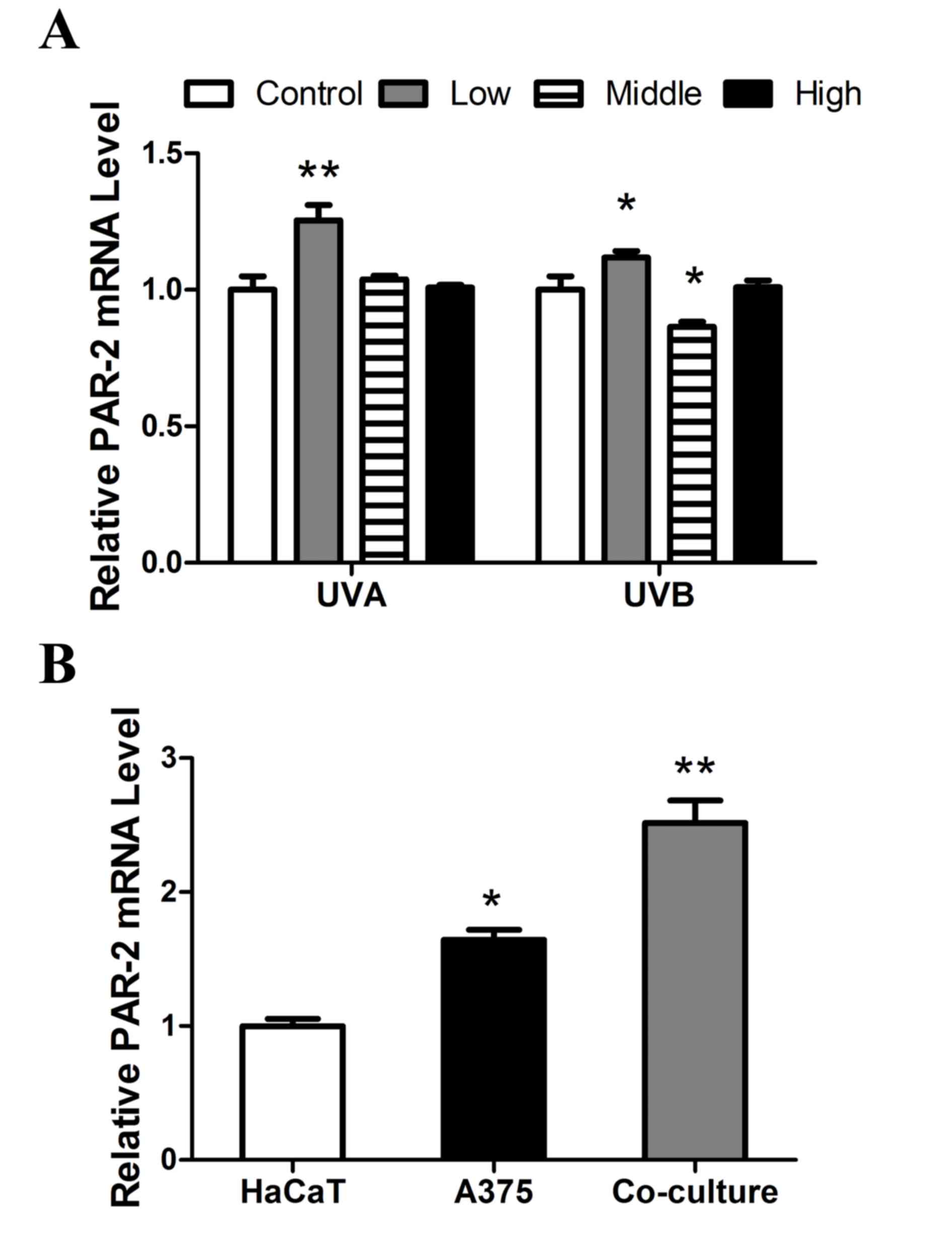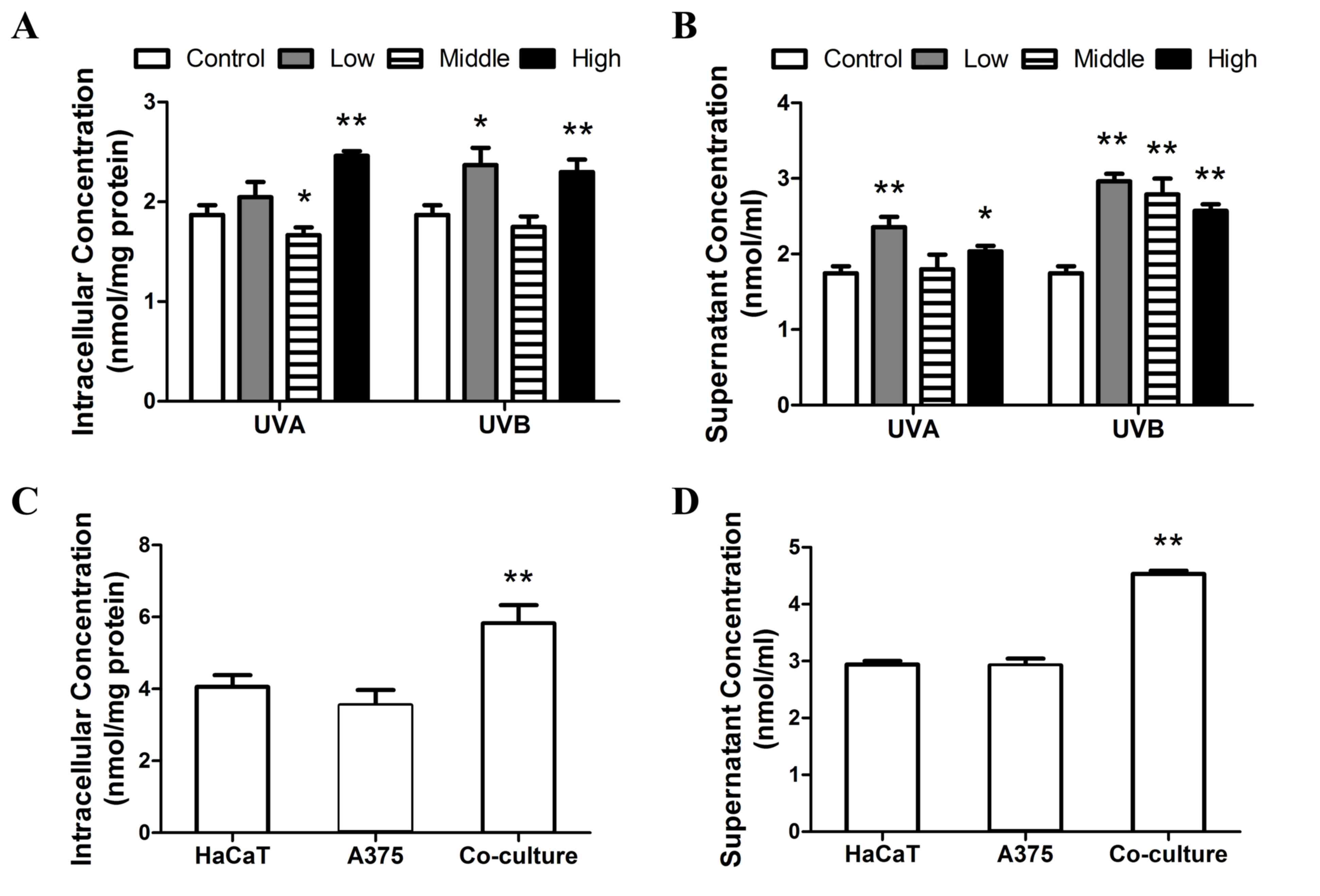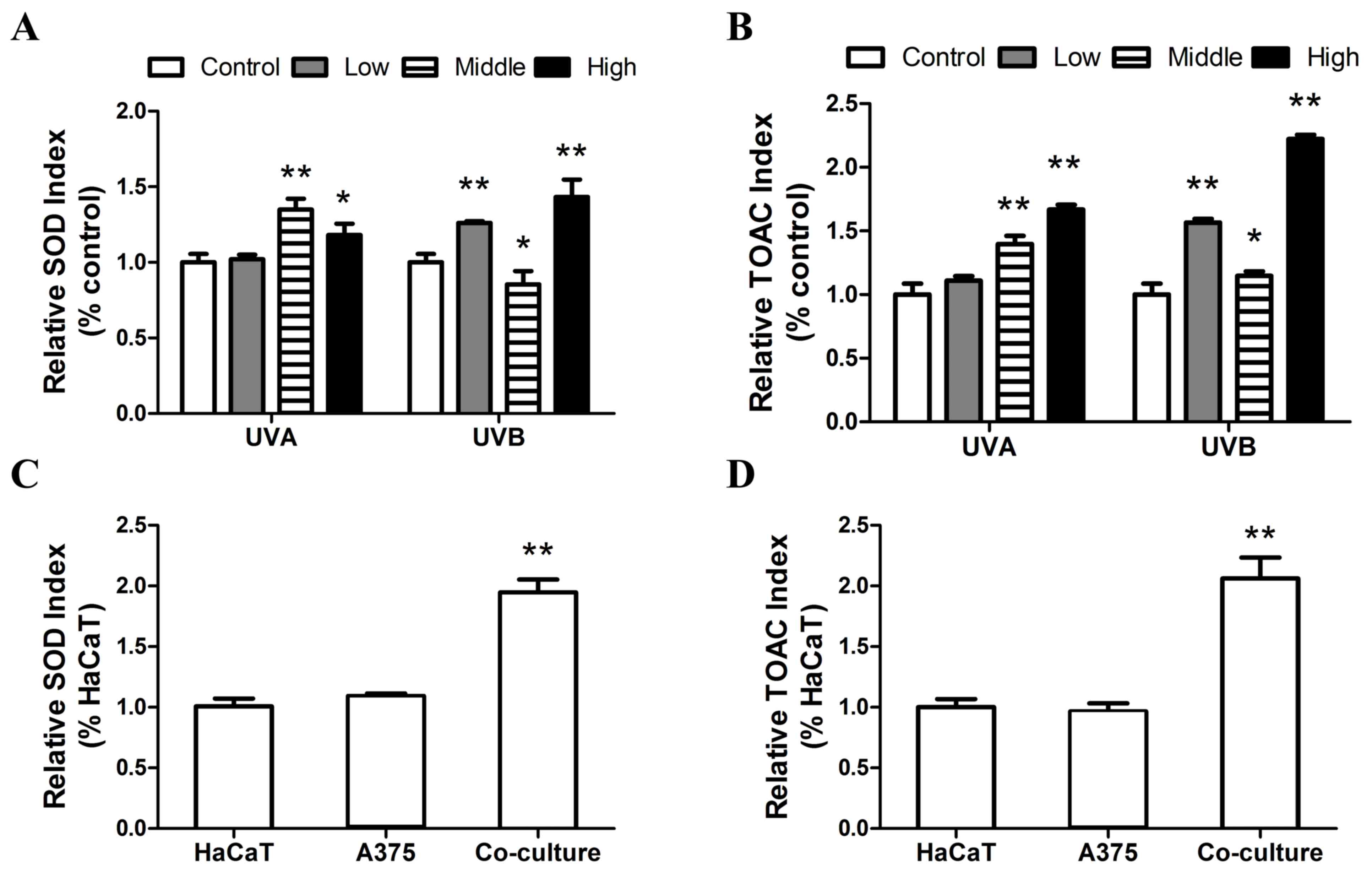|
1
|
Njoo MD, Spuls PI, Bos JD, Westerhof W and
Bossuyt PM: Nonsurgical repigmentation therapies in
vitiligo-Meta-analysis of the literature. Arch Dermatol.
134:1532–1540. 1998. View Article : Google Scholar : PubMed/NCBI
|
|
2
|
Ezzedine K, Eleftheriadou V, Whitton M and
van Geel N: Vitiligo. Lancet. 386:74–84. 2015. View Article : Google Scholar : PubMed/NCBI
|
|
3
|
Chu ECY: Treatment of vitiligo: Medical
treatment, phototherapy and surgical treatment. Hong Kong J
Dermatol Venereol. 23:113–117. 2015.
|
|
4
|
Kanwar AJ, Dogra S, Parsad D and Kumar B:
Narrow-band UVB for the treatment of vitiligo: An emerging
effective and well-tolerated therapy. Int J Dermatol. 44:57–60.
2005. View Article : Google Scholar : PubMed/NCBI
|
|
5
|
Wu CS, Yu CL, Wu CS, Lan CCE and Yu HS:
Narrow-band ultraviolet-B stimulates proliferation and migration of
cultured melanocytes. Exp Dermatol. 13:755–763. 2004. View Article : Google Scholar : PubMed/NCBI
|
|
6
|
El Mofty M, Bosseila M, Mashaly HM, Gawdat
H and Makaly H: Broadband ultraviolet A vs. psoralen ultraviolet A
in the treatment of vitiligo: A randomized controlled trial. Clin
Exp Dermatol. 38:830–835. 2013. View Article : Google Scholar : PubMed/NCBI
|
|
7
|
Huang XX, Bernerd F and Halliday GM:
Ultraviolet a within sunlight induces mutations in the epidermal
basal layer of engineered human skin. Am J Pathol. 174:1534–1543.
2009. View Article : Google Scholar : PubMed/NCBI
|
|
8
|
Yasui H and Sakurai H: Chemiluminescent
detection and imaging of reactive oxygen species in live mouse skin
exposed to UVA. Biochem Biophys Res Commun. 269:131–136. 2000.
View Article : Google Scholar : PubMed/NCBI
|
|
9
|
He YY and Häder DP: UV-B-induced formation
of reactive oxygen species and oxidative damage of the
cyanobacterium Anabaena sp.: Protective effects of ascorbic acid
and N-acetyl-L-cysteine. J Photochem Photobiol B. 66:115–124. 2002.
View Article : Google Scholar : PubMed/NCBI
|
|
10
|
Swalwell H, Latimer J, Haywood RM and
Birch-Machin MA: Investigating the role of melanin in UVA/UVB-and
hydrogen peroxide-induced cellular and mitochondrial ROS production
and mitochondrial DNA damage in human melanoma cells. Free Radic
Biol Med. 52:626–634. 2012. View Article : Google Scholar : PubMed/NCBI
|
|
11
|
Pelle E, Mammone T, Maes D and Frenkel K:
Keratinocytes act as a source of reactive oxygen species by
transferring hydrogen peroxide to melanocytes. J Invest Dermatol.
124:793–797. 2005. View Article : Google Scholar : PubMed/NCBI
|
|
12
|
Sravani PV, Babu NK, Gopal KV, Rao GR, Rao
AR, Moorthy B and Rao TR: Determination of oxidative stress in
vitiligo by measuring superoxide dismutase and catalase levels in
vitiliginous and non-vitiliginous skin. Indian J Dermatol Venereol
Leprol. 75:268–271. 2009. View Article : Google Scholar : PubMed/NCBI
|
|
13
|
Chui DH, Tang W and Orkin SH: cDNA cloning
of murine Nrf 2 gene, coding for a p45 NF-E2 related transcription
factor. Biochem Biophys Res Commun. 209:40–46. 1995. View Article : Google Scholar : PubMed/NCBI
|
|
14
|
McMahon M, Itoh K, Yamamoto M and Hayes
JD: Keap1-dependent proteasomal degradation of transcription factor
Nrf2 contributes to the negative regulation of antioxidant response
element-driven gene expression. J Biol Chem. 278:21592–21600. 2003.
View Article : Google Scholar : PubMed/NCBI
|
|
15
|
Itoh K, Wakabayashi N, Katoh Y, Ishii T,
Igarashi K, Engel JD and Yamamoto M: Keap1 represses nuclear
activation of antioxidant responsive elements by Nrf2 through
binding to the amino-terminal Neh2 domain. Genes Dev. 13:76–86.
1999. View Article : Google Scholar : PubMed/NCBI
|
|
16
|
Déry O, Corvera CU, Steinhoff M and
Bunnett NW: Proteinase-activated receptors: Novel mechanisms of
signaling by serine proteases. Am J Physiol. 274:C1429–C1452. 1998.
View Article : Google Scholar : PubMed/NCBI
|
|
17
|
Moretti S, Nassini R, Prignano F, Pacini
A, Materazzi S, Naldini A, Simoni A, Baroni G, Pellerito S, Filippi
I, et al: Protease-activated receptor-2 downregulation is
associated to vitiligo lesions. Pigment Cell Melanoma Res.
22:335–338. 2009. View Article : Google Scholar : PubMed/NCBI
|
|
18
|
Rattenholl A and Steinhoff M:
Proteinase-activated receptor-2 in the skin: Receptor expression,
activation and function during health and disease. Drug News
Perspect. 21:369–381. 2008. View Article : Google Scholar : PubMed/NCBI
|
|
19
|
Hachem JP, Houben E, Crumrine D, Man MQ,
Schurer N, Roelandt T, Choi EH, Uchida Y, Brown BE, Feingold KR and
Elias PM: Serine protease signaling of epidermal permeability
barrier homeostasis. J Invest Dermatol. 126:2074–2086. 2006.
View Article : Google Scholar : PubMed/NCBI
|
|
20
|
Hachem JP, Man MQ, Crumrine D, Uchida Y,
Brown BE, Rogiers V, Roseeuw D, Feingold KR and Elias PM: Sustained
serine proteases activity by prolonged increase in pH leads to
degradation of lipid processing enzymes and profound alterations of
barrier function and stratum corneum integrity. J Invest Dermatol.
125:510–520. 2005. View Article : Google Scholar : PubMed/NCBI
|
|
21
|
Steinhoff M, Corvera CU, Thoma MS, Kong W,
McAlpine BE, Caughey GH, Ansel JC and Bunnett NW:
Proteinase-activated receptor-2 in human skin: Tissue distribution
and activation of keratinocytes by mast cell tryptase. Exp
Dermatol. 8:282–294. 1999. View Article : Google Scholar : PubMed/NCBI
|
|
22
|
Steinhoff M, Neisius U, Ikoma A, Fartasch
M, Heyer G, Skov PS, Luger TA and Schmelz M: Proteinase-activated
receptor-2 mediates itch: A novel pathway for pruritus in human
skin. J Neurosci. 23:6176–6180. 2003.PubMed/NCBI
|
|
23
|
Scott G, Deng A, Rodriguez-Burford C,
Seiberg M, Han R, Babiarz L, Grizzle W, Bell W and Pentland A:
Protease-activated receptor 2, a receptor involved in melanosome
transfer, is upregulated in human skin by ultraviolet irradiation.
J Invest Dermatol. 117:1412–1420. 2001. View Article : Google Scholar : PubMed/NCBI
|
|
24
|
Sasaki M, Horikoshi T, Uchiwa H and
Miyachi Y: Up-regulation of tyrosinase gene by nitric oxide in
human melanocytes. Pigment Cell Res. 13:248–252. 2000. View Article : Google Scholar : PubMed/NCBI
|
|
25
|
Roméro-Graillet C, Aberdam E, Clément M,
Ortonne JP and Ballotti R: Nitric oxide produced by
ultraviolet-irradiated keratinocytes stimulates melanogenesis. J
Clin Invest. 99:635–642. 1997. View Article : Google Scholar : PubMed/NCBI
|
|
26
|
El-Mofty M, Mostafa W, Youssef R,
El-Fangary M, El-Ramly A, Mahgoub D, Fawzy M and El-Hawary M:
BB-UVA vs. NB-UVB in the treatment of vitiligo: A randomized
controlled clinical study (single blinded). Photodermatol
Photoimmunol Photomed. 29:239–246. 2013. View Article : Google Scholar : PubMed/NCBI
|
|
27
|
Livak KJ and Schmittgen TD: Analysis of
relative gene expression data using real-time quantitative PCR and
the 2(-Delta Delta C(T)) method. Methods. 25:402–408. 2001.
View Article : Google Scholar : PubMed/NCBI
|
|
28
|
Ohkawa H, Ohishi N and Yagi K: Assay for
lipid peroxides in animal tissues by thiobarbituric acid reaction.
Anal Biochem. 95:351–358. 1979. View Article : Google Scholar : PubMed/NCBI
|
|
29
|
Plaa GL and Witschi H: Chemicals, drugs,
and lipid peroxidation. Annu Rev Pharmacol Toxicol. 16:125–142.
1976. View Article : Google Scholar : PubMed/NCBI
|
|
30
|
Roelandts R: Photo (chemo) therapy for
vitiligo. Photodermatol Photoimmunol Photomed. 19:1–4. 2003.
View Article : Google Scholar : PubMed/NCBI
|
|
31
|
Wang HT, Choi B and Tang MS: Melanocytes
are deficient in repair of oxidative DNA damage and UV-induced
photoproducts. Proc Natl Acad Sci USA. 107:pp. 12180–12185. 2010;
View Article : Google Scholar : PubMed/NCBI
|
|
32
|
Roméro-Graillet C, Aberdam E, Clément M,
Ortonne JP and Ballotti R: Nitric oxide produced by
ultraviolet-irradiated keratinocytes stimulates melanogenesis. J
Clin Invest. 99:635–642. 1997. View Article : Google Scholar : PubMed/NCBI
|
|
33
|
He YY, Pi J, Huang JL, Diwan BA, Waalkes
MP and Chignell CF: Chronic UVA irradiation of human HaCaT
keratinocytes induces malignant transformation associated with
acquired apoptotic resistance. Oncogene. 25:3680–3688. 2006.
View Article : Google Scholar : PubMed/NCBI
|
|
34
|
He YY, Huang JL and Chignell CF: Delayed
and sustained activation of extracellular signal-regulated kinase
in human keratinocytes by UVA: Implications in carcinogenesis. J
Biol Chem. 279:53867–53874. 2004. View Article : Google Scholar : PubMed/NCBI
|
|
35
|
Lehmann J, Pollet D, Peker S, Steinkraus V
and Hoppe U: Kinetics of DNA strand breaks and protection by
antioxidants in UVA- or UVB-irradiated HaCaT keratinocytes using
the single cell gel electrophoresis assay. Mutat Res. 407:97–108.
1998. View Article : Google Scholar : PubMed/NCBI
|
|
36
|
Hirota A, Kawachi Y, Itoh K, Nakamura Y,
Xu X, Banno T, Takahashi T, Yamamoto M and Otsuka F: Ultraviolet A
irradiation induces NF-E2-related factor 2 activation in dermal
fibroblasts: Protective role in UVA-induced apoptosis. J Invest
Dermatol. 124:825–832. 2005. View Article : Google Scholar : PubMed/NCBI
|
|
37
|
Hseu YC, Chou CW, Senthil Kumar KJ, Fu KT,
Wang HM, Hsu LS, Kuo YH, Wu CR, Chen SC and Yang HL: Ellagic acid
protects human keratinocyte (HaCaT) cells against UVA-induced
oxidative stress and apoptosis through the upregulation of the HO-1
and Nrf-2 antioxidant genes. Food Chem Toxicol. 50:1245–1255. 2012.
View Article : Google Scholar : PubMed/NCBI
|
|
38
|
Kimura S, Warabi E, Yanagawa T, Ma D, Itoh
K, Ishii Y, Kawachi Y and Ishii T: Essential role of Nrf2 in
keratinocyte protection from UVA by quercetin. Biochem Biophys Res
Commun. 387:109–114. 2009. View Article : Google Scholar : PubMed/NCBI
|
|
39
|
Marrot L, Jones C, Perez P and Meunier JR:
The significance of Nrf2 pathway in (photo)-oxidative stress
response in melanocytes and keratinocytes of the human epidermis.
Pigment Cell Melanoma Res. 21:79–88. 2008. View Article : Google Scholar : PubMed/NCBI
|
|
40
|
Bhatnagar A, Kanwar A, Parsad D and De D:
Comparison of systemic PUVA and NB-UVB in the treatment of
vitiligo: An open prospective study. J Eur Acad Dermatol Venereol.
21:638–642. 2007.PubMed/NCBI
|
|
41
|
Armstrong BK and Kricker A: The
epidemiology of UV induced skin cancer. J Photochem Photobiol B.
63:8–18. 2001. View Article : Google Scholar : PubMed/NCBI
|
|
42
|
Rhodes LE, Belgi G, Parslew R, McLoughlin
L, Clough GF and Friedmann PS: Ultraviolet-B-induced erythema is
mediated by nitric oxide and prostaglandin E 2 in combination. J
Invest Dermatol. 117:880–885. 2001. View Article : Google Scholar : PubMed/NCBI
|
|
43
|
Brash DE, Ziegler A, Jonason AS, Simon JA,
Kunala S and Leffell DJ: Sunlight and sunburn in human skin cancer:
p53, apoptosis, and tumor promotion. J Investig Dermatol Symp Proc.
1:136–142. 1996.PubMed/NCBI
|
|
44
|
Faraonio R, Vergara P, Di Marzo D,
Pierantoni MG, Napolitano M, Russo T and Cimino F: p53 suppresses
the Nrf2-dependent transcription of antioxidant response genes. J
Biol Chem. 281:39776–39784. 2006. View Article : Google Scholar : PubMed/NCBI
|
|
45
|
Rushworth SA, Zaitseva L, Murray MY, Shah
NM, Bowles KM and MacEwan DJ: The high Nrf2 expression in human
acute myeloid leukemia is driven by NF-κB and underlies its
chemo-resistance. Blood. 120:5188–5198. 2012. View Article : Google Scholar : PubMed/NCBI
|
|
46
|
Joshi PG, Nair N, Begum G, Joshi NB,
Sinkar VP and Vora S: Melanocyte-keratinocyte interaction induces
calcium signalling and melanin transfer to keratinocytes. Pigment
Cell Res. 20:380–384. 2007.PubMed/NCBI
|
|
47
|
Scott G, Deng A, Rodriguez-Burford C,
Seiberg M, Han R, Babiarz L, Grizzle W, Bell W and Pentland A:
Protease-activated receptor 2, a receptor involved in melanosome
transfer, is upregulated in human skin by ultraviolet irradiation.
J Invest Dermatol. 117:1412–1420. 2001. View Article : Google Scholar : PubMed/NCBI
|
|
48
|
Paine C, Sharlow E, Liebel F, Eisinger M,
Shapiro S and Seiberg M: An alternative approach to depigmentation
by soybean extracts via inhibition of the PAR-2 pathway. J Invest
Dermatol. 116:587–595. 2001. View Article : Google Scholar : PubMed/NCBI
|
|
49
|
Lerner DJ, Chen M, Tram T and Coughlin SR:
Agonist recognition by proteinase-activated receptor 2 and thrombin
receptor. Importance of extracellular loop interactions for
receptor function. J Biol Chem. 271:13943–13947. 1996. View Article : Google Scholar : PubMed/NCBI
|
|
50
|
Molino M, Barnathan ES, Numerof R, Clark
J, Dreyer M, Cumashi A, Hoxie JA, Schechter N, Woolkalis M and
Brass LF: Interactions of mast cell tryptase with thrombin
receptors and PAR-2. J Biol Chem. 272:4043–4049. 1997. View Article : Google Scholar : PubMed/NCBI
|
|
51
|
Molino M, Woolkalis MJ, Reavey-Cantwell J,
Praticó D, Andrade-Gordon P, Barnathan ES and Brass LF: Endothelial
cell thrombin receptors and PAR-2. Two protease-activated receptors
located in a single cellular environment. J Biol Chem.
272:11133–11141. 1997. View Article : Google Scholar : PubMed/NCBI
|
|
52
|
Scott G, Leopardi S, Parker L, Babiarz L,
Seiberg M and Han R: The proteinase-activated receptor-2 mediates
phagocytosis in a Rho-dependent manner in human keratinocytes. J
Invest Dermatol. 121:529–541. 2003. View Article : Google Scholar : PubMed/NCBI
|















